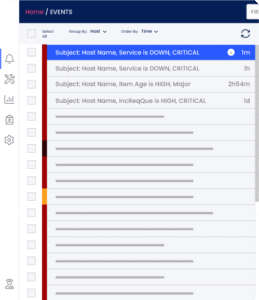Interview Series with the Experts of Big Data, Cloud, SaaS, and DevOps
– Conversations in the Cloud – Kristine Simon from IBM
Introduction
We’re excited to introduce our new conversation in the cloud series, featuring experts across the cloud industry. We’ve lined up some amazing experts to interview for this series. As a company, we specialize in Uptime Management services to technology companies, assuring service availability at all times. We deliver NOC/SOC service convergence along with Hybrid infrastructure systems, encompassing tailored monitoring solutions, ongoing infrastructure maintenance and cloud integration. With that intro, who better to lead off our cloud series than Technical Specialist of Big Data, Kristine Simon of IBM?! Follow Kristine on Twitter @kristinesimon
Kristine, you’ve been involved with IBM for a while, tell us more about that
I recently rejoined IBM in August to be on the Big Data / Information Management software team. Meaning I’m a technology specialist for the entire big data portfolio. Prior to IBM, I was a tech specialist for Business Intelligence for four years in the corporate performance management area. Ten years ago I worked at IBM in Global Business Services on the JD Edwards and SAP Alliance teams. My professional experience spans sales and marketing for software, hardware and services in traditional systems of transactions to the current systems of engagement. What interests me today is the merging of all of the financial and operational data created within an organization to the data that exists everywhere in our lives, such as machine and social. Big data is the next piece of the puzzle that can help deliver on the promised of analytics everywhere.
What does big data really mean?
Great question! Big data seems to have become a buzz word that means everything. In my mind, it is the convergence of ALL of the structured, including dark data, married with the ALL of the unstructured data into a pool that can be mined for insight. Data is now a natural resource and speed helps accelerate the time to value and competitive advantages, such as new business models, improved customer interaction and service, and improved IT economics.
How do you see big data impacting future SaaS companies and startups?
Yes, it is already in a trend in the marketplace and big data as a service is already available. IBM offers Big Insights, our open source Hadoop offering plus IBM components, as part of our cloud offerings. Why this is important, is the speed at which companies can benefit from big data and provide a competitive advantage.
What are some of your most exciting big data successes?
Automotive, Retail and Finance are the industries I see the widest adoption of big data. One of my favorites is the connected car and how we can start to engage as a consumer with car dealers and manufacturers. Another exciting big data solution involves retail. Retail has changed, and the companies who take advantage of big data can take advantage of localized merchandising and 360 degree view of the customer.
IBM has been investing in big data, especially with its recent partnership with Twitter, why the shift?
I see the partnership between IBM and Twitter as the appropriate evolution. I went back to college in 2005 to pursue my bachelor’s in advertising and public relations. What attracted me to that degree was the wealth of data that had been created with traditional systems, such as ERP, CRM, HCM and Supply Chain, in additional to the new data, such as SEO and social analytics being created in the world. Twitter provides the best pulse on world sentiment and the analytics are staggering, perfect fit for any company who wants to combine this data with analytics. IBM is known for innovation, and you can see based on our R&D budget it is important to innovate the quality of data our clients will have access to.
Should big data be available at all times?
Now big data is real time, and we calling it fast data. In the case of national security, yes all the time. In the case of retail, yes leaner businesses need to add to their bottom line by tightening up the supply chain and inventory. In healthcare, it is paramount to have bid data available 24×7 to help monitor, treat patients and provide the platform to prevent disease.
What should be the ideal big data architecture to ensure optimal uptime efficiency?
The modern architecture is one that provides a place for the systems, data warehouse, and analytic tools you have in place today, then augments with well integrated, purpose-built components that provide dedicated processing for faster, deeper, analysis and modeling.
- Leverage data in motion to streamline extreme volumes,
- Hadoop to capture operational data and new types for data exploration,
- Extend transformation, matching, security and governance capabilities to ALL data.
Big data and IoT – How do you view their synergy?
It is hard to separate the IoT and big data; you need that wealth of information from all of the machines around us in order to manage the inputs and outputs. Typical overlap presents itself in the home, auto or hospital. We need to be able to collect and synthesis that information being created by the machines in ways that blends into everyday without being distracted.
Predictions for the future of big data?
It is moving to the cloud and it will have a cognitive component to it. There is so much data, we will need the help of the computers to analyze and make sense of the correlations. Where will all the conversation be in a year? Cognitive Computing at the speed of life, a number of companies will have developed solutions that seem to know us and what we want, and we will be interacting using natural language processing and wearable technology.
If a business is embarking into integrating big data decisions now, what are 3 tips you would offer?
- Develop a use case before starting. I see a lot of companies trying to jump on the band wagon by downloading open source then not being able to create the business case. A use case provides you with a roadmap and a path to success.
- Focus on one phase at a time. Implementing a big data and analytics platform is a journey and it needs to be adaptable because the business objectives are as well. Some of the insights might surprise you and lead you down another path for phase II.
- Don’t forget security as a part of your plan. Adult supervision, information governance, is necessary as you build a platform for big data and analytics to protect the data and to give your users confidence they have the right data.
Great suggestions and predictions for Big Data here, Kristine! All of our clients can certainly learn from your answers on how to approach Big Data and how it can shape the growth trajectory of any cloud-based business.
Thanks so much for your time, Kristine! You’re a great Big Data expert to start off our Conversations in the Cloud series.
Know of any experts in the industry that we should interview? Let us know below.


